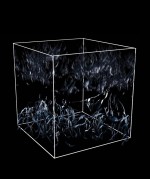Title
The annual Beyond the Machine concerts spotlight Juilliard musicians creating and performing demanding electro-acoustic music. This year's series unfolds over two weekends. The first, BTM 16.1, is a presentation of works-in-progress, some of which Journal reporter Joseph Bricker and others saw in a November series of presentations.
Body
Three siblings watch time go by in a dark, horror movie-esque basement. The moldy cellar is filled with blacks, grays, greens; there are drops and creaks and footsteps. As these children have done every day for the past five years, they wait until nightfall, at which point, they put on a variety show for the rats and shadows that inhabit the space with them. Once the show begins, you're enveloped in a wash of vibrant reds and whites with glitter and tacky show music, the image of the basement is completely eliminated and you're transported into a utopia.
This image comes from a preliminary presentation of Our Names in Masking Tape, a piece that's part of the multimedia, multidivision extravaganza Beyond the Machine 16.1, which is put on by Juilliard's Center for Innovation in the Arts. This piece was created through InterArts, a program that allows students and alums to develop Beyond the Machine projects. The sessions I attended in November also included one in which faculty members Edward Bilous (MM '80, DMA '84, composition), William Fastenow, and Michelle DiBucci (MM '87, composition) used the production software Logic to dissect a recording of a gunshot and adjust it by layering more gunshots and flexing the pitch so that it sounds larger than life. Later the three of them used the speaker configuration in the Willson Theater to control a recording of a helicopter taking flight so that audience members experienced the sound rising to the ceiling and floating around their heads. These demonstrations and others showed the students in attendance that we should truly let our imaginations run wild—the goal should be creating the most captivating production possible. That said, I must mention that sound designer/producer Nathan Prillaman (MM '15, composition) and the production team were pretty outstanding—I was blown away at what they did with these works-in-process presentations.
Our Names in Masking Tape was just one of several storyboard presentations for Beyond the Machine projects that I saw in the fall. Before they started, Bilous, who is the director of the Center for Innovation in the Arts, told me that every time he'd walked in while the students were working on their presentations, he'd seen "amazing stuff coming together." I did too. Our Names in Masking Tape was much more complex than indicated at the beginning of this article. For instance, live security camera footage flipped from the children in the basement to a feed of the audience that's used as a twisted/creepy laugh-cam.
Another work, Filter, was designed to depict how one experiences the passage of time after a loss. Through a visual spectrum/animation following a black screen and white lines, dancer Magdalyn Segale (BFA '14, dance) acted as a filter for forces and experiences that the mind cannot control, and a mix of electronic and acoustic music, some live and some prerecorded. This allowed for a very organic mix of performance and technology, making the piece extremely accessible and nuanced.
The third piece, Foul Play, was a mixture of popular culture sports and Shakespeare in a classier version of High School Musical. Each quarter of a football game incorporated a different dramatic production; some cool features included a projection of a mouth speaking directly onto a football and talking back to a player (think Hamlet), and a sound-meter to detect how fired up the audience is by the action.
The fourth piece, Trust Me, was the only music-centric one, and it followed a format similar to that of Ravel's Bolero: it got more and more busy and loud until the very end, when it dropped off and left the audience hanging. Throughout the piece videos and images of Cold War-era propaganda were projected onto a screen, and they became more and more complicated as the piece became more intense. They were designed to highlight the "governmental transparency" of the Cold War, which was juxtaposed with electronic musicians hiding what they were doing (queuing music or video, or manipulating either). The piece was jarring and made the audience very uncomfortable due to the ambiguity of roles and its "What am I supposed to be thinking?" nature.
Overall, this year's Beyond the Machine is shaping up to be a very powerful event. Wrapping the audience in a blanket of powerful ambience and striking narrative, there will be no lack of creative power and innovation.





